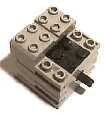We tested the behavior of the three kinds of LEGO Technic Motors. All of the results below were performed running at 100% power off of a Handy Board, with the Ni-Cad pack measuring 9.8 V open-circuit, and around 9 V under load (for the first two motors, didn't measure the micro motor under load). For students in the seminar, note that this is a partially-drained but still reasonably good battery pack.
We measured the no-load speed with a precise high-speed strobe light borrowed from the Edgerton Center at MIT.
We measured the stall-torque by placing "Lego brand weights" at different lego distances from the motor shaft and seeing at what distance it could just barely lift them.
In the future, we'll measure more points on the torque-speed curve and get more precise torque measurements, but just knowing stall torque and no-load speed and assuming the torque-speed curve is a straight line is a good first pass approximation.
The results show that not only is the gear motor "smooth-feeling" and "high torque" as other people have mentioned, it has a power output roughly 2-3 times that of the generic Lego Motor, so it is the best motor to use in many situations. (especially since it costs the same amount as the generic lego motor)
| The Motor | Description | No-load Speed (within a few %) | Stall Torque (within 10%?) |
Approx. Peak Power (1/2 no-load speed * 1/2 stall torque) |
 |
The generic Lego Motor, part #5114. | 1420 RPM 149 rad/s |
1.0 N-cm 0.01 N-m 1.4 oz-in |
0.37 N-m/s (Watts) |
 |
The Lego Gear Motor, part #5225. | 375 RPM 39 rad/s |
8.9 N-cm 0.089 N-m 12.3 oz-in 0.06 ft-lb |
0.87 N-m/s (Watts) |
 |
The Lego Micro Motor, part #5119. | 30 RPM 3.1 rad/s |
1.9 N-cm 0.019 N-m 2.6 oz-in |
0.015 N-m/s (Watts) |